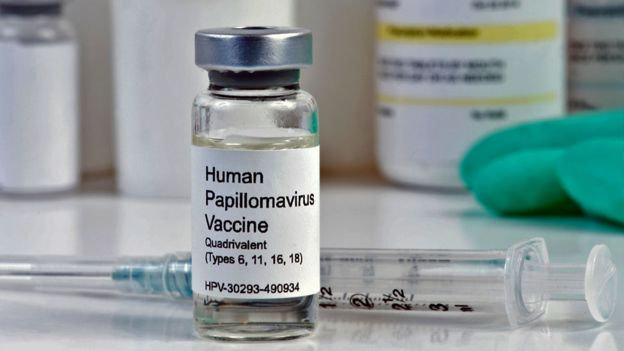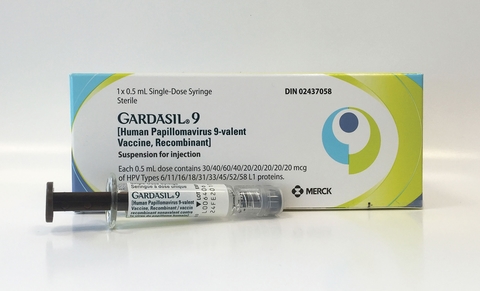Study Shows That Quadrivalent HPV Vaccine Might Be Better Suited For Boys and Males Compared To Nonavalent Or Bivalent HPV Vaccine.
Source: Thailand Medical News Nov 26, 2019 5 years, 11 months, 2 weeks, 4 days, 8 hours, 35 minutes ago
A new study published in the Cochrane Library provides further information on the benefits and harms of different
human papillomavirus (
HPV) vaccines and vaccine schedules in young women and men.
Human Papillomavirus is the most common viral infection of the reproductive tract in both women and men globally. Most people who have sexual contact will be exposed to
HPV at some point in their life. In most people, their own immune system will clear the
HPV infection.
However,
HPV infection can sometimes persist if the immune system does not clear the virus. Persistent infection with some ‘high-risk’ strains of
HPV can lead to the development of cancer. High-risk
HPV strains cause almost all cancers of the cervix and anus, and some cancers of the vagina, vulva, anus, penis, and head and neck. Other ‘low risk’,
HPV strains cause genital warts but do not cause cancer.

Cancer development due to
HPV happens gradually, over many years, through a number of pre-cancer stages, called intra-epithelial neoplasia. In the cervix (neck of the womb) these changes are called cervical intraepithelial neoplasia (CIN). High-grade CIN changes have a 1 in 3 chance of developing into cervical cancer, but many CIN lesions regress and do not develop into cancer.
HPV-related cancers accounted for an estimated 4.5% of cancers worldwide in 2012.
HPV vaccination aims to prevent future
HPV infection and the cancers caused by high-risk
HPV infection.
HPV vaccines are mainly targeted towards adolescent girls because cancer of the cervix is the most common HPV-associated cancer. For the prevention of cervical cancer, the World Health Organization recommends vaccinating girls aged 9-14 years with
HPV vaccine using a two-dose schedule (0, 6 months) as the most effective strategy. A three-dose schedule is recommended for older girls ≥15 years of age or for people with human immunodeficiency virus (HIV) infection or other causes of immunodeficiency.
Currently three
HPV vaccines are in use: a bivalent vaccine that is targeted at the two most common high-risk
HPV types; a quadrivalent
vaccine targeted at four
HPV types, and a nonavalent vaccine targeted at nine
HPV types. In women, the bivalent and quadrivalent vaccines have been shown to protect against pre-cancer of the cervix caused by the
HPV types contained in the
vaccine if given before natural infection with
HPV.
The study in Cochrane Review summarizes the results from 20 randomized controlled trials involving 31,940 people conducted across all continents. In most studies, the outcome reported was the production of
HPV antibodies by the vaccine recipient’s immune system.
HPV antibody responses predict protection
against the
HPV-related diseases and cancers the
vaccines are intended to prevent. Antibody response is often used as a surrogate in
HPV vaccine studies because it takes many years for pre-cancer to develop after
HPV infection, so it is difficult for studies to follow participants over such long periods of time. Moreover, because trial participants were tested for
HPV infection and offered treatment, if
HPV-related precancer was found, progression to cervical cancer in this group would be expected to be very low, even without vaccination.
In four studies that compared a two-dose vaccine schedule with a three-dose schedule in 2,317 adolescent girls and three studies compared different time intervals between the first two
vaccine doses in 2,349 girls and
boys. Antibody responses were similar after two-dose and three-dose
HPV vaccine schedules in girls. Antibody responses in girls and boys were stronger when the interval between the first two doses of
HPV vaccine was longer.
Evidence from one study of 16 to 26-year old men showed that the quadrivalent HPV vaccine reduces the incidence of external genital lesions and genital warts compared with a group who did not receive the HPV vaccine.
The quadrivalent HPV vaccine bears the trade name Gardasil (Merck) and contains VLPs of the L1 protein of HPV types 6, 11, 16, and 18 (HPV 6/11/16/18) synthesized in Sacchromyces cerevisiae and adsorbed on amorphous aluminum hydroxyphosphate sulfate adjuvant.
Thailand Medical News Notes that there is now GARDASIL®9 (Human Papillomavirus 9-valent Vaccine, Recombinant) that is effective agains 9 different HPV strains.

Evidence from a study of 16 to 26-year old women that compared the nonavalent and quadrivalent
vaccines showed that they provide a similar level of protection against cervical, vaginal, and vulval pre-cancerous lesions.
Evidence from seven studies about
HPV vaccines in people living with HIV showed that
HPV antibody responses in children living with HIV were higher after vaccination with either bivalent or quadrivalent vaccine than with a non-
HPV control
vaccine. These antibody responses against HPV could be maintained for up to two years. The evidence about clinical outcomes and harms for
HPV vaccines in people with HIV was very limited.
Also, evidence suggested that up to 90% of
males and females who received an
HPV vaccine experienced local minor adverse events such as redness, swelling and pain at the injection site. Due to the low rates of serious adverse events in quadrivalent and nonavalent
vaccine groups, and the broad definition of these events used in the trials, we cannot really determine the relative safety of different
vaccine schedules.
Dr. Jo Morrison, the lead editor of this review and Consultant in Gynaecological Oncology, Musgrove Park Hospital, Somerset, UK, told
Thailand Medical News, “We need long-term population-level studies to provide data on the effects of dosing intervals, schedules and
vaccines on
HPV-related cancers, as well as giving us a more complete picture of rare harms. However, with fewer doses having a similar antibody response, and more extensive evidence from
vaccine studies in
boys, policy makers are now in a better position to determine how local vaccination programs can be designed. It would be interesting to see how different schedules and
vaccines influence immunization coverage, but this review, and the studies within it, were not designed to be able to answer that question.”
Reference: Bergman et al. (2019) Comparison of different human papillomavirus (HPV) vaccine types and dose schedules for prevention of HPV-related disease in females and males. Cochrane Systematic Review. DOI: https://doi.org/10.1002/14651858.CD013479 
